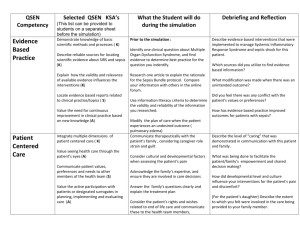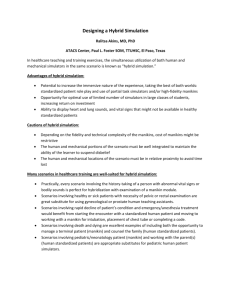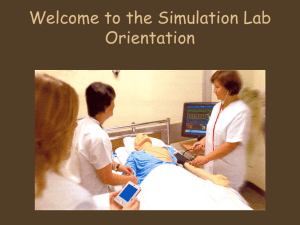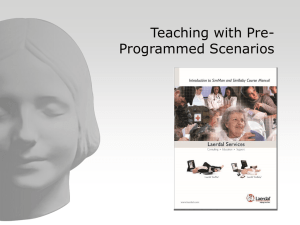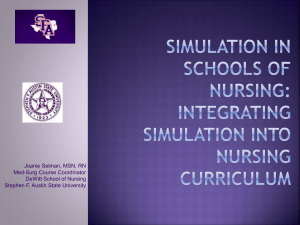File - Erin Ropelewski
advertisement
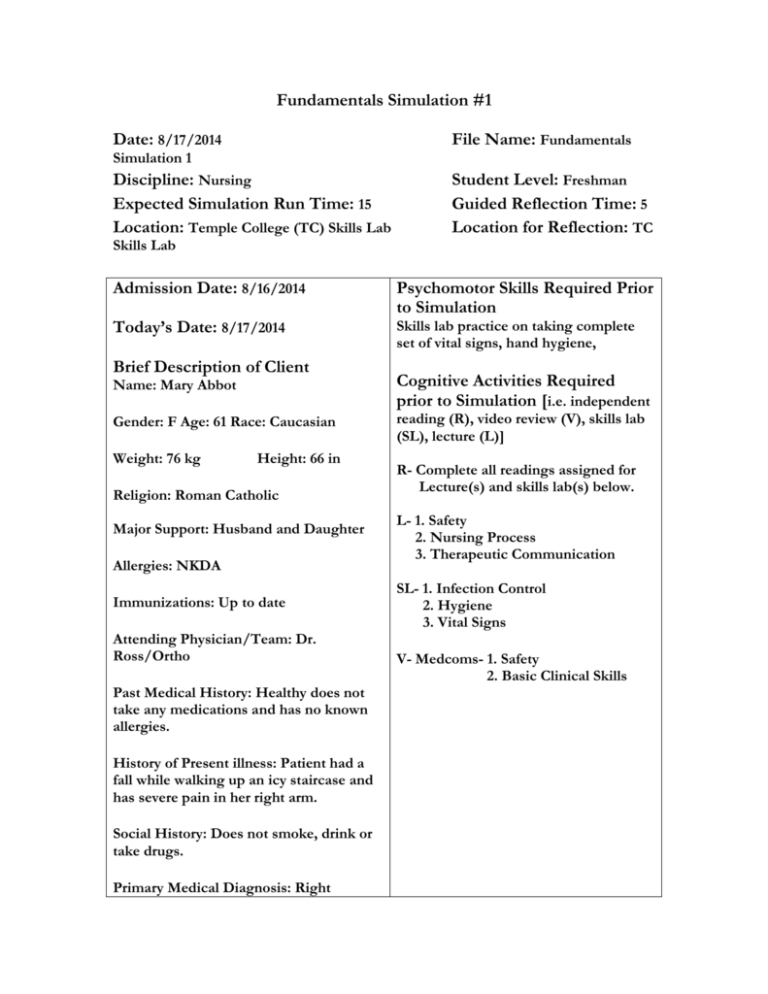
Fundamentals Simulation #1 Date: 8/17/2014 File Name: Fundamentals Simulation 1 Discipline: Nursing Expected Simulation Run Time: 15 Location: Temple College (TC) Skills Lab Student Level: Freshman Guided Reflection Time: 5 Location for Reflection: TC Skills Lab Admission Date: 8/16/2014 Today’s Date: 8/17/2014 Brief Description of Client Psychomotor Skills Required Prior to Simulation Skills lab practice on taking complete set of vital signs, hand hygiene, Name: Mary Abbot Cognitive Activities Required prior to Simulation [i.e. independent Gender: F Age: 61 Race: Caucasian reading (R), video review (V), skills lab (SL), lecture (L)] Weight: 76 kg Height: 66 in Religion: Roman Catholic Major Support: Husband and Daughter Allergies: NKDA Immunizations: Up to date Attending Physician/Team: Dr. Ross/Ortho Past Medical History: Healthy does not take any medications and has no known allergies. History of Present illness: Patient had a fall while walking up an icy staircase and has severe pain in her right arm. Social History: Does not smoke, drink or take drugs. Primary Medical Diagnosis: Right R- Complete all readings assigned for Lecture(s) and skills lab(s) below. L- 1. Safety 2. Nursing Process 3. Therapeutic Communication SL- 1. Infection Control 2. Hygiene 3. Vital Signs V- Medcoms- 1. Safety 2. Basic Clinical Skills humeral closed fracture Surgeries/Procedures & Dates: none Nursing Diagnoses: Acute pain related to recent injury AEB: Verbal report of pain Observed evidence of trauma to right arm Protective gestures/guarding Impaired physical mobility related to musculoskeletal impairment AEB: Limited ability to perform gross motor skills. Simulation Learning Objectives Upon completion of this simulation scenario the student will: 1. Obtain a complete set of vitals signs (BP, Apical pulse/radial pulse, respirations, temperature, pulse oximeter, and include pain level). (NCLEX: Physiological Integrity; QSEN: Patient Centered Care) 2. Identify and correct any safety issues found in the patients room. (NCLEX: Safe and Effective Care Environment; QSEN: Safety) 3. Report all findings to the charge nurse using the SBAR format. (NCLEX: Management of Care; QSEN: Teamwork and Collaboration) Fidelity (choose all that apply to this simulation) Setting/Environment Medications and Fluids ER Med-Surg Peds ICU OR / PACU Women’s Center Behavioral Health Home Health Pre-Hospital Other: Please ensure the bed is raised, one side rail is down and the call light is not within reach of the patient at the start IV Fluids: Oral Meds: IVPB: IV Push: IM or SC: Diagnostics Available Labs X-rays (Images) 12-Lead EKG Other: of the scenario. Simulator Manikin/s Needed: One SimMan manikin Props: sling for right arm Equipment attached to manikin: IV tubing with primary line fluids running at mL/hr Secondary IV line running at mL/hr IV pump Foley catheter mL output PCA pump running IVPB with running at mL/hr 02 Monitor attached ID band Other: Heplocked IV, Blood Pressure cuff, pulse oximeter, stethoscope and thermometer at bedside. Documentation Forms Physician Orders Admit Orders Flow sheet Medication Administration Record Kardex Graphic Record Shift Assessment Triage Forms Code Record Anesthesia / PACU Record Standing (Protocol) Orders Transfer Orders Other: Recommended Mode for Simulation (i.e. manual, programmed, etc.) Full Scale Simulation- “using a computerized full-body manikin that can be programmed to provide realistic physiological responses to student actions (Cant & Cooper, 2010).” Equipment available in room Bedpan/Urinal Foley kit Straight Catheter Kit Incentive Spirometer Fluids IV start kit IV tubing IVPB Tubing IV Pump Feeding Pump Pressure Bag 02 delivery device (type) Crash cart with airway devices and emergency medications Defibrillator/Pacer Suction Other: Roles/Guidelines for Roles Primary Nurse Student Information Needed Prior to Scenario: Secondary Nurse Clinical Instructor Family Member #1 Family Member #2 Observer/s Recorder Physician/Advanced Practice Nurse Respiratory Therapy Anesthesia Pharmacy Lab Imaging Social Services Clergy Unlicensed Assistive Personnel Code Team Other: Important Information Related to Roles: Observer will shadow the student in the nurse role. Being that this is the student’s first simulation experience the student in the nurse role will be able to “phone a friend” and ask for assistance if they are having trouble. Observer will be allowed to provide assistance if needed. Significant Lab Values: none Physician Orders: Vitals Q4H Activity OOB as tolerated Morphine Sulfate 10mg PO Q6H PRN. Motrin 800mg PO Q8H Has been oriented to simulator Understands guidelines /expectations for scenario Has accomplished all presimulation requirements All participants understand their assigned roles Has been given time frame expectations Other: Report Students Will Receive Before Simulation Time: 1000- Morgan Abbot is a 62-year-old female who is an inpatient on the medsurg floor for pain management while awaiting and ORIF of her right humerus. She had a fall on the ice yesterday resulting in a fracture of her arm. Past medical history is insignificant, and she takes no regular medications. No known allergies. Patient received her morning meds and assessment was completed. You received report from the charge nurse to cover this patient while her primary nurse is off the floor. Patient is due for a full set of vital signs to include pain assessment. After completion you are to report back to the charge nurse with your findings. References, Evidence-Based Practice Guidelines, Protocols, or Algorithms Used For This Scenario (site source, author, year, and page): Latchman J., 2014. Improving pain management at the nursing education level: evaluating knowledge and attitudes. J Adv Pract Oncol. 5(1):10-6. Whittingham KA, Oldroyd LE, 2014. Using an SBAR - keeping it real! Demonstrating how improving safe care delivery has been incorporated into a top-up degree programme. Nurse Educ Today. 34(6):e47-52. Schwappach DL, Gehring K, 2014. Silence That Can Be Dangerous: A Vignette Study to Assess Healthcare Professionals' Likelihood of Speaking up about Safety Concerns. PLoS One, 12;9(8). Faculty Role: The facilitator of the simulation scenario will be responsible for ensuring that the simulation is set up appropriately and that students are briefed and have an understanding of the objectives and what they need to accomplish. Faculty member will follow the script and the progression as closely as possible to ensure all students have equivalent learning experiences. Faculty member will fill out the checklist found in this simulation guide. Facilitator of the simulation scenario will also lead the debriefing portion using the 3D Model of Debriefing: Defusing, Discovering, and Deepening. Please refer to the handbook for more information on debriefing method or refer to the following article as needed: Zigmont, J. J., Kappus, L. J., & Sudikoff, S. N. (2011, April). The 3D model of debriefing: Defusing, discovering, and deepening. Seminars in Perinatology, 35(2), 5258. Checklist that will be found in student syllabus for this scenario. Simulation Checklist for Satisfactory Needs Fundamentals Scenario 1 Improvement Washes hands Introduces Self Identifies the patient (name, ID Band, DOB) Obtains vitals (BP, Apical pulse/radial pulse, respirations, temperature, SpO2). Conducts a pain assessment using a pain scale. Conducts a safety survey and corrects and safety issues Report is given to the charge nurse using SBAR format. Scenario Progression Outline Timing (approximate) 5 Minutes 5 to 10 Minutes 10 to 15 Minutes Manikin Actions Expected Interventions May Use the Following Cues Vocal sounds: Answers questions regarding identification: “My name is Mary Abbot and my birthday is on September 7, 1952.” Wash hands Role member providing cue: Patient Identifies patient by name and ID band Cue: “Who are you?” If student fails to introduce self Vocal sounds: Asks: “Is everything OK?” Informs patient regarding the need to obtain viral signs Role member providing cue: Patient Introduces self States, “Oh wow, that Obtains vital signs thing on my arm is way to tight!” Cue: If student fails to ID the patient. “You are the first person who hasn't checked my bracelet I guess you guys really know who I am by now anyway.” Vocal sounds: Pain assessment: “It is throbbing, I would rate it a 5 out of 10.” Role member providing cue: Charge Nurse Completes a pain assessment Addresses safety issues in the room “I really don't want to Report is given to charge nurse become addicted to (instructor) these pain pills.” Cue: Patient will ask for call bell if student is not addressing safety issues May prompt student by asking questions if information is left out on report. Complexity – Simple to Complex Suggestions for Changing the Complexity of This Scenario to Adapt to Different Levels of Learners This is a very basic scenario meant to be the first high fidelity experience for the novice nursing student. This scenario can be a base for any other scenario. A head to toe assessment could be added on easily to elevate this scenario to a slightly higher level. The patients’ prior medical history could also be changed and the scenario could address the issues you would face with a diabetic who is NPO prior to surgery. Since this is at the most basic level individual instructors can tweak this scenario to address whatever case they need to in this high fidelity scenario. The scenario could also be made even more basic by having the visit take place in the office for a well visit with no broken
